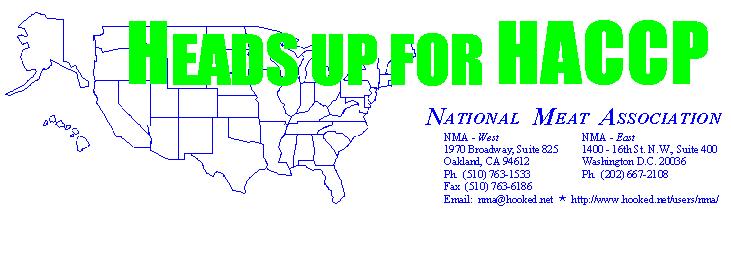

Edited by Jeremy Russell
January 12, 1998
HACCP PRINCIPLE #3: ESTABLISH CRITICAL LIMITS FOR EACH CRITICAL CONTROL POINT
Identifying Critical Limits For Critical Control Pointr
By Robert A. Savage President, The HACCP Consulting Group, L.L.C.
As you develop your HACCP plan and identify hazards that are reasonably likely to occur, control measures must be used at critical control points (CCPs) to control the identified hazards. Each control measure must have associated with it one or more critical limits for food safety. A critical limit is defined as a criterion that must be met for each control measure associated with a CCP to prevent, eliminate or reduce to an acceptable level the identified biological, chemical or physical hazard. Another way of looking at critical limits is that they are boundries of safety for a control measure at each CCP.
Each CCP can have one or more control measures to assure that the identified hazards are prevented, eliminated or reduced to acceptable levels. Likewise, each control measure can have one or more associated critical limits. Critical limits may be based upon factors such as: temperature, time, available chlorine, sensory information such as aroma and visual appearance or the sensitivity of metal detectors to detect foreign material in a product. Critical limits and criteria for food safety may be derived from sources such as the USDA, FSIS, Meat and Poultry regulations, FDA regulations, the FDA Food Code, scientific literature, experimental results, and from experts.
In some cases, processing variations may require certain target levels to assure that critical limits are met. For example, a control measure and critical limit may be an internal product temperature of 160�F during the cooking process. However, if the oven temperature varies by +/- 5�F, the oven target temperature would have to be greater than 165�F so that no product receives a cook less than 160�F. In such a case, while the HACCP plan would identify a critical limit for safety as 160�F, operating instructions to the oven operator would identify 165�F or perhaps 170�F to avoid deviations below the critical limit for safety that would require corrective actions to be taken.
In another example, critical limits that may be associated with control measures for beef slaughter might be the operating conditions of a steam vacuum system, steam pasteurization system or acetic acid rinse to achieve a known level of bacterial reduction on the carcass. These values could be found in the scientific literature or developed by in-plant testing.
In all cases, plants should maintain a file of references and sources regarding where their critical limits were obtained in their HACCP plan. As new information is developed and new technologies developed to reduce harmful bacteria in meat and poultry products, the plant's HACCP team should review its critical limits to ensure they are still adequate. Likewise, if new pathogenic bacteria are identified, critical limits must be reviewed to ensure they are still adequate to prevent, eliminate or reduce to acceptable levels to hazard.